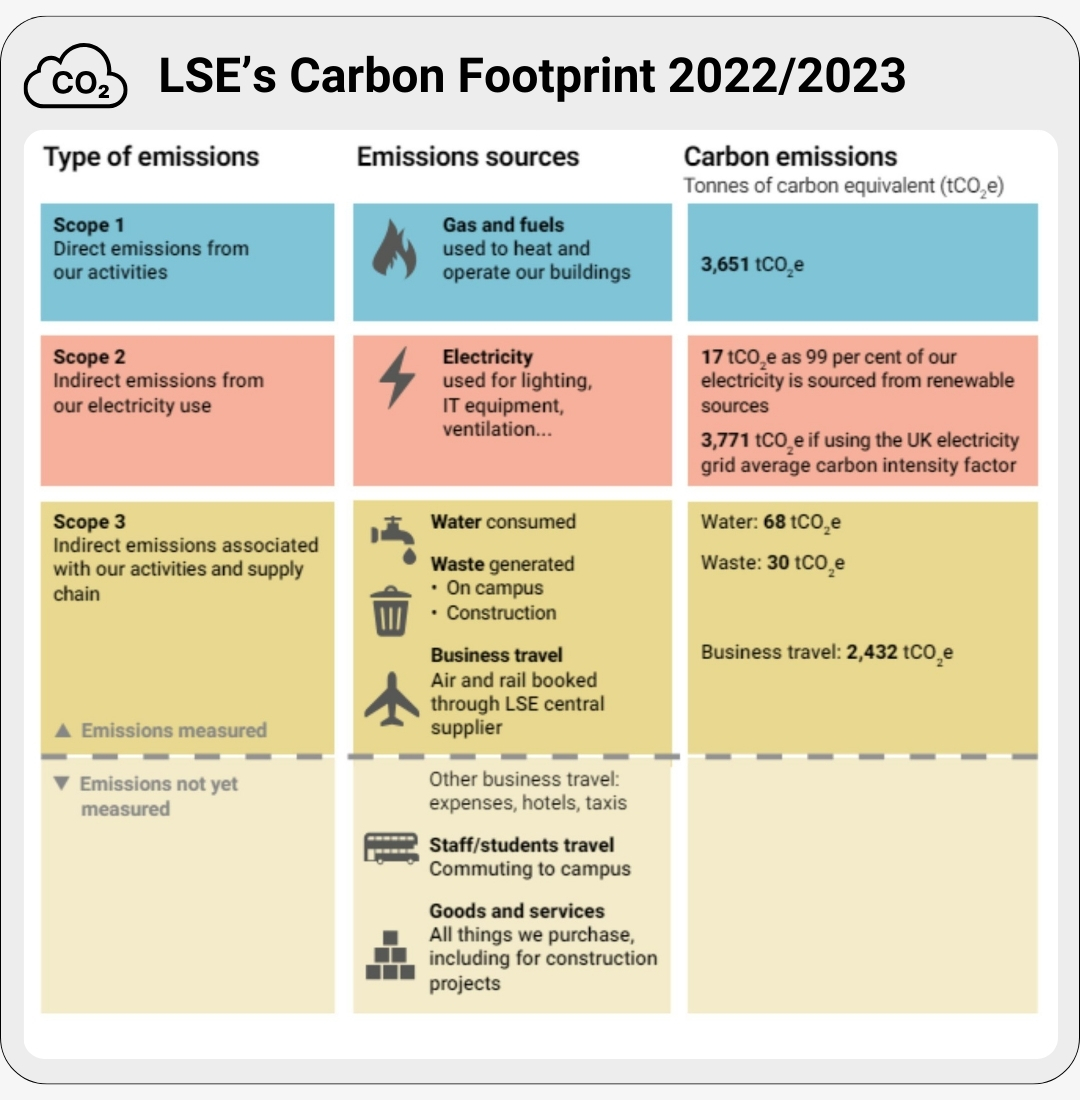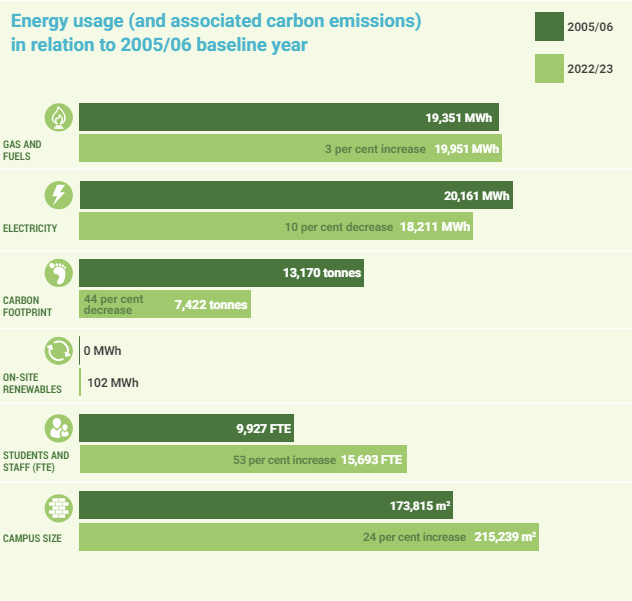 LSE’s carbon targets
LSE’s carbon targets
- Achieved - Our scope 1 and 2 carbon footprint has reduced by 44 per cent since 2005. Our 2022/23 carbon footprint for scope 1 and 2 emissions was 7,422 tonnes tCO2 e. Our carbon intensity was 34.5 kg CO2 e/m2 , a 54 per cent reduction since 2005/06.
- Achieve net-zero carbon emissions by 2030 for our most direct emissions (scope 1 and 2) and by 2050 at the latest for our indirect emissions (scope 3), adopting a challenging carbon reduction pathway aligned to climate science and using carbon removal measures for our residual emissions.
This Q&As has more details about the difference between carbon neutral and net-zero carbon.
Carbon Management Plan:
Progress towards our carbon targets is detailed in our Carbon Management Plan.
Click here to view our 2022/23 Carbon Management Plan.
Measure
LSE measures and calculates its carbon emissions using internationally recognised methodologies and conversion factors published by the UK government. LSE’s carbon footprint is reported annually. Our latest published footprint (2022/23) is shown below:
Methodology: we apply best practice methodology by using the international Greenhouse Gas Protocol (or GHG Protocol). Using this, we publicly report our emissions annually via the UK Estates Management Record which is collated and available for download via the Higher Education Statistics Authority.
Our raw data originates from:
- Electricity, gas and onsite renewables: automatic meter readings (95%) manual readings and invoices (5%)
- Water: readings and invoices (100%)
- Waste: 60% measures, 40% calculated
- Fuel usage: bills
- Air and rail business travel: travel supplier reporting
- Business mileage: business expenses
Our baseline: Our baseline is a static snapshot in time that we compare against. LSE and the majority of other higher education institutions received guidance from HEFCE mandating 2005/06 academic year as our baseline year for our scope 1 and 2 emissions.
Carbon factors: We use the latest UK Government carbon factors each year to calculate our carbon emissions. Occasionally, the UK Government will issue a change that applies retrospectively, such as in 2013.
Scope 3 Methodology: In line with the GHG Protocol, we follow a hierarchy of methodologies, from less refined e.g using spend as a proxy to calculate carbon impact, to more accurate e.g. using exact data (see more information here). Scope 3 emission sources can include emissions related to:
- Indirect utilities impacts: water and wastewater, waste and recycling
- Business travel
- Day-to-day commuting to campus
- International students travelling to LSE
- Purchase of goods and services
- Investments
Our Qualifying Explanatory Statement includes a full emissions inventory with more details of which scope 3 emissions we currently measure.
Reduce
Since 2015 we have invested £4.8million in energy efficiency projects across campus. We reduced the carbon emissions linked to our energy use (scope 1 and 2) by 44% since 2005 despite an increase in campus size and the number of staff and students.
We are committed to continue following a challenging carbon reduction pathway, to deliver our target to be net zero carbon by 2030 for our most direct emissions (scope 1 and 2) and by 2050 at the latest for our indirect emissions (Scope 3).
Our Net Zero Carbon by 2030 commitment for Scope 1 and 2 emissions translate into a further 50% absolute carbon reduction against a 2018/19 baseline. Our Carbon Reduction Strategy developed in 2020/21 describes the different potential measures identified to deliver this target, which the Estates Division and the School are now further progressing with oversight and monitoring by staff and students as part of the Sustainability Operations Group.
In relation to our 2005/2006 baseline year, we have seen a 44% reduction in our carbon footprint.

Our net zero carbon target means a combination of:
Carbon reductions - Deliver absolute carbon reductions aligned to a 1.5 degree celsius Science-Based Target
Carbon mitigation - Use only carbon removal type projects to mitigate residual emissions. This means projects removing and sequestrating carbon emissions from the atmosphere, for instance planting new trees or using Carbon Capture and Storage (CCS) technology.
Science-Based Targets are developed using independent models that calculate the level of carbon reduction a particular organisation needs to achieve in order to do its 'fair share' in reducing global emissions and keep global warming below 2 or 1.5 degrees celsius from pre-industrial levels in line with the Paris Climate Agreement. This means LSE is using a robust and internationally recognised method to set itself an ambitious carbon reduction target.
An absolute carbon reduction measures an actual reduction in total emissions. Importantly carbon offsets are not counted towards an absolute reduction target, but only used to mitigate any remaining residual emissions.
Mitigate
LSE takes the additional measure of mitigating the emissions it cannot yet avoid, by:
- Purchasing renewable energy
- Funding high-quality carbon mitigation projects
1. Purchasing renewable energy
LSE purchases its energy through the LASER consortium. The electricity purchased by LSE is sourced from 100% renewable sources (e.g. solar and wind) and backed by a REGO (Renewable Energy Guarantees of Origin) Certificate. The REGO scheme provides transparency about the proportion of electricity that suppliers source from renewable generation. LSE’s Scope 2 emissions from the purchase of electricity are fully mitigated using this approach.
2. Funding high-quality carbon mitigation projects
There are environmental benefits in funding carbon emissions reductions projects outside of LSE, which would otherwise not take place, thus contributing to supporting carbon emissions reductions at a global level.
LSE only supports high-quality carbon offsetting projects which meet robust certification standards.
LSE partnered with the not for profit Compensate Foundation to support high-quality carbon reduction projects abroad. Compensate takes a thorough approach in selecting and monitoring carbon mitigation projects for their integrity in delivering demonstrable carbon reduction impact, and other social and environmental co-benefits.
The development of LSE’s carbon credits portfolio has also been an educational opportunity, with LSE academics and students actively involved. The LSE community voted for a portfolio focused on forest conservation projects, for their additional positive impacts on biodiversity and creating economic opportunities for local communities. A summary of the projects we support can be found in this Q&As and more details on our Moodle page.
Carbon reductions should always be a key priority over carbon mitigation. And LSE recognises the need to move as soon as practical to carbon removal type projects, as part of achieving its net-zero carbon targets.
You can find more information about our approach to carbon mitigation in this Q&As.
-
Be Digital Smart: keep it on the screen to reduce printing and collaborate online to avoid travel.
-
If you need to conduct business travel, book using our supplier Diversity to ensure your travel emissions are mitigated.
-
Rethink your commute: opt to cycle, run or walk to improve your health, wellbeing and save money.
-
Switch it off. If you're away from your computer for over 5 minutes switch off the screen, and shut it down at the end of the day.
-
Too hot or cold in the office? Dress for the season, then contact the Estates Helpdesk to request a change in temperature if necessary. Personal heaters and fans can confuse office thermostats and make everyone too hot or cold.
-
Last one out? Switch off lighting and equipment.
-
Take the stairs rather than the lift: It's good for you and the planet.